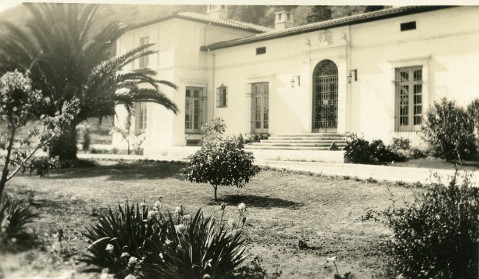George IV’s Grandson Held San Andres Property
Site was owned by Army Surgeon, Rancher, and Avocado Grower

The building at 935 San Andres Street, presently home to Shoreline Community Church, has a long, interesting lineage. The first owner of this property was a former U.S. Army surgeon, James Lycurgus Ord. Ord came to California as part of an artillery unit in 1847. He was the grandson of King George IV, the result of a secret marriage between the king and a Roman Catholic woman, Mary Anne Fitzherbert, in 1785. Fort Ord in Monterey County was named after one of his brothers, Edward O. C. Ord.
In 1856, Ord married Angústias de la Guerra, a daughter of José de la Guerra, one of California’s most distinguished citizens of the pre-American period. Her mother was a Carrillo, another august California name. Angústias de la Guerra Ord later dictated her memories of early California, which were published as Occurrences in Hispanic California.
James Ord practiced medicine here and also ranched. He was one of the first to attempt to raise avocados in California. He also served for a time as U.S. consul-general in Mexico. He was an officer of the Santa Ynez Turnpike Company, which built the main stagecoach road over the Santa Ynez Range by way of San Marcos Pass. During the late 1850s and early 1860s, Ord served as county coroner. He purchased the San Andres parcel in 1858. A tax assessment roll of the mid-1860s valued it at around $100 with a tax of a little less than $2.
The Ords divorced in 1875, and James later remarried. The San Andres property eventually was passed down to the daughter of James and Angústias, Rebecca. She married John Henry Hobart Peshine in 1887. Peshine had served in both the navy and the army during the Civil War. He fought as a volunteer for the French in the Franco-Prussian War in the early 1870s. He later was assigned as military attaché in Madrid in the years immediately before the 1898 outbreak of the Spanish-American War. He and his wife settled in Santa Barbara in 1903, shortly after his retirement.
The couple erected a grand mansion on the San Andres site with money received from a Lompoc Valley oil lease. Completed at a cost of $110,000 in 1917, the Spanish-style home included a chapel of white marble and a pipe organ. The architect was Myron Hunt of Los Angeles, designer of the Rose Bowl in Pasadena. His Santa Barbara–area designs included the San Marcos Building and La Arcada, both in the 1100 block of State Street; the Faulkner Memorial Galley at the public library; and the Cima del Mundo estate in Montecito.
After Rebecca Peshine’s death, the San Andres home went through a number of owners until two women bought it in 1946 and transformed it into the Chapel Inn, which operated for five years. When Grace Church bought it in 1954, the building was being used as a fraternity.
Grace Church had grown out of a series of Sunday schools held in people’s homes. More formally organized in 1947, the congregation initially met in a room in the Lobero Building on Anacapa Street, before moving to larger quarters in the Carrillo Auditorium, formerly at 222 West Carrillo Street. The church continued to grow after its move to the Peshine site, adding a complex of buildings including a nursery and Sunday school. Various congregations have called the site home through the years.
Michael Redmon, director of research at the Santa Barbara Historical Museum, will answer your questions about Santa Barbara’s history. Write him c/o The Santa Barbara Independent, 122 West Figueroa Street, Santa Barbara, CA 93101.



